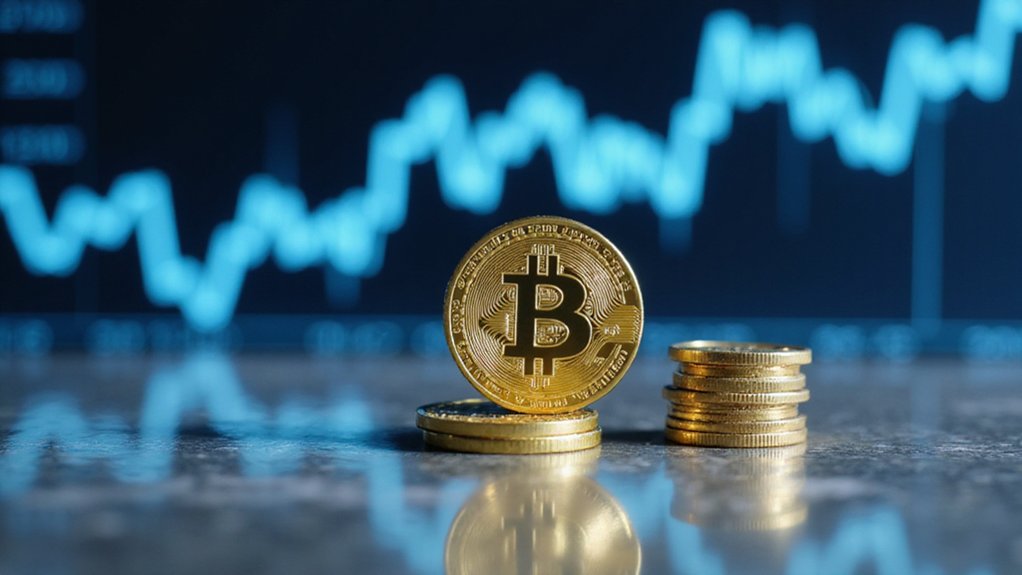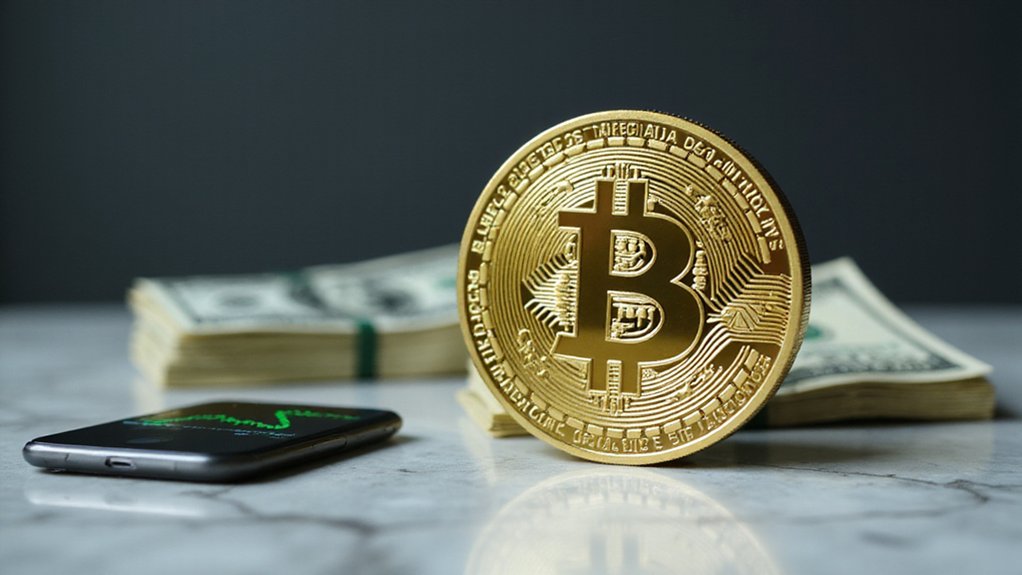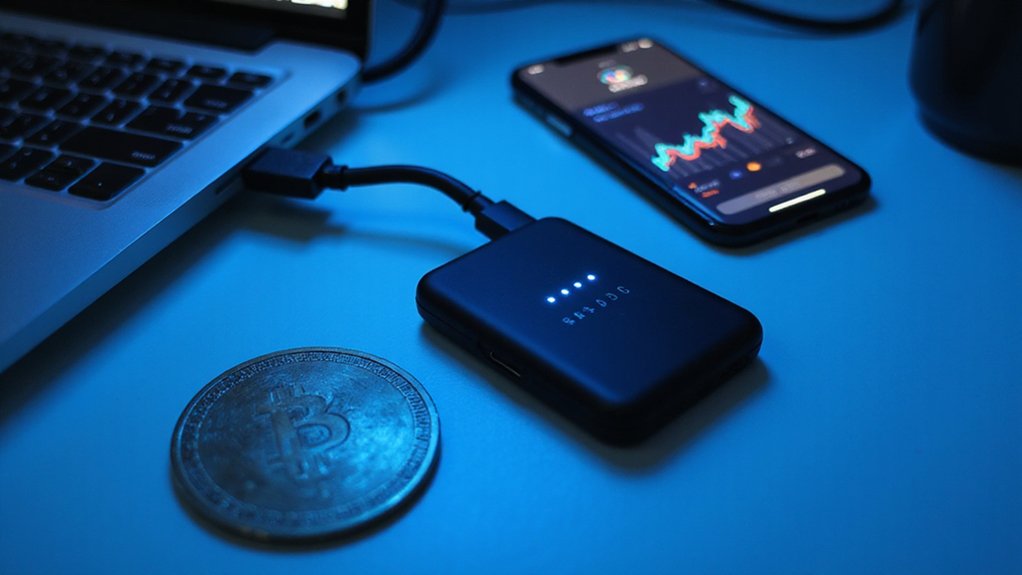A stablecoin is a digital asset designed to maintain consistent value by pegging itself to external references like the U.S. dollar or gold. Unlike Bitcoin’s notorious volatility, stablecoins offer predictable value retention—making them suitable for everyday transactions and remittances without requiring minute-by-minute price chart consultations. These financial instruments come in fiat-collateralized, crypto-collateralized, and algorithmic varieties, each employing different stability mechanisms. The $162 billion stablecoin market represents blockchain’s pragmatic compromise between revolutionary ambition and functional utility.

A stablecoin represents the cryptocurrency world’s pragmatic compromise between revolutionary ambition and practical utility—a digital asset designed specifically to maintain a consistent value by being pegged to an external reference like the U.S. dollar, euro, or even commodities such as gold.
Unlike their wildly fluctuating crypto cousins (Bitcoin, one imagines, would make a terrible currency for buying coffee), stablecoins offer what traditional markets have long taken for granted: predictable value retention.
Bitcoin’s price volatility makes it an absurd choice for everyday purchases—imagine needing a price chart just to buy breakfast.
This stability makes them particularly suitable for everyday transactions, remittances, and payment systems within blockchain ecosystems.
The mechanisms underpinning stablecoin stability fall into several distinct categories, each with its own risk profile and philosophical approach.
Fiat-collateralized variants—the financial conservatives of the stablecoin world—maintain reserves of actual currency in bank accounts, with USDC and Tether serving as prominent examples.
Crypto-collateralized alternatives, meanwhile, secure their value through other cryptocurrencies held in smart contracts, typically over-collateralized to account for volatility.
Algorithmic stablecoins, perhaps the most intellectually intriguing yet practically problematic, maintain their peg through supply and demand adjustments controlled by code rather than collateral—a fascinating experiment in digital monetary policy that has, on occasion, spectacularly failed. These innovative tokens use software algorithms to automatically adjust their circulating supply based on market demand.
The total market capitalization of stablecoins now exceeds $162 billion, a figure that has attracted increasing regulatory scrutiny.
This attention isn’t unwarranted—the reserves backing these tokens aren’t always transparent, and redemption issues loom as potential systemic risks.
Tether (USDT), as the most popular stablecoin, provides essential liquidity across different blockchain platforms while facing ongoing questions about its reserve transparency.
Even the most established stablecoins have experienced de-pegging events during market stress.
Despite these challenges, stablecoins serve vital functions in the cryptocurrency ecosystem.
They facilitate decentralized finance applications, provide trading pairs on exchanges to reduce exposure to volatile assets, and serve as a gateway between traditional finance and the crypto world.
Fundamentally, they represent blockchain’s attempt to create a functional medium of exchange that doesn’t require users to check prices every five minutes—a modest ambition, perhaps, but a necessary evolution for a technology aspiring to mainstream utility.
Many merchants prefer stablecoins for cryptocurrency payments because they eliminate the speculation risk that comes with price volatility.
Frequently Asked Questions
Can Stablecoins Be Used for International Remittances?
Stablecoins offer a compelling solution for international remittances, providing notable advantages over traditional transfer methods.
Their blockchain foundation enables near-instantaneous cross-border transactions at substantially reduced costs (often mere pennies compared to the double-digit percentage fees of conventional services).
With remarkable growth in Latin America, where remittance flows reached $156 billion in 2023, stablecoins like USDC and USDT bypass intermediaries while maintaining value stability—a critical feature for those sending financial lifelines across continents.
How Do Stablecoins Impact Traditional Banking Systems?
Stablecoins represent both existential threat and evolutionary catalyst to traditional banking.
They potentially disrupt core revenue streams (payments, deposits) while reshaping balance sheets and credit provision mechanisms.
When replacing cash, they expand bank balance sheets; when supplanting deposits, they contract available lending capital.
The banking sector faces a Schumpterian moment of creative destruction—forced to either adapt by integrating stablecoin infrastructure or watch as decentralized protocols increasingly disintermediate their historical role as financial gatekeepers.
What Regulatory Challenges Do Stablecoins Face Globally?
Stablecoins face a regulatory quagmire globally, with jurisdictional conflicts creating enforcement blind spots across borders.
Reserve management remains troublingly opaque, lacking standardized disclosure requirements while vulnerability to runs looms large.
Anti-money laundering efforts stumble against pseudonymous transactions and fragmented VASP oversight.
Meanwhile, regulatory arbitrage flourishes amid divergent approaches—from Europe’s thorough MiCA framework to America’s patchwork oversight and EMDEs’ varying capacity to monitor these increasingly systemically important instruments.
Are Stablecoins Vulnerable to Cybersecurity Threats?
Stablecoins face significant cybersecurity vulnerabilities across multiple attack vectors.
Their smart contract infrastructure—the very code underpinning their stability—remains susceptible to exploitation, as evidenced by the recent $49.5 million USDC theft.
Operational risks compound these concerns, with network disruptions and governance issues creating systemic vulnerabilities.
Furthermore, the human element persists as a critical weakness; poor private key management and insider threats represent substantial risks that even the most technically sound stablecoin implementations cannot entirely mitigate.
Can Stablecoins Help With Financial Inclusion in Developing Countries?
Stablecoins offer remarkable potential for financial inclusion in developing nations through multiple vectors: reducing remittance costs from prohibitive 10%+ fees to mere 1-3%; providing banking alternatives for the 1.7 billion unbanked globally; enabling near-instant cross-border transfers; and facilitating microfinance opportunities previously unavailable.
While infrastructure limitations (sporadic internet access, smartphone penetration) and regulatory uncertainties present hurdles, the technology’s capacity to democratize financial services—particularly in regions with unstable currencies—represents a promising pathway toward economic empowerment and poverty reduction.









